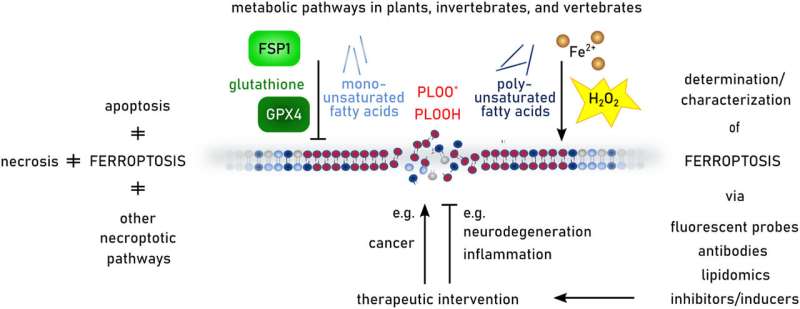This article has been reviewed according to Science X's editorial process and policies. Editors have highlighted the following attributes while ensuring the content's credibility:
fact-checked
peer-reviewed publication
trusted source
proofread
Ferroptosis: Comprehensive review of important cell death mechanism

Ferroptosis is a cell death mechanism that has only become known comparatively recently, being named in 2012. This so-called non-apoptotic cell death occurs when too many oxygen radicals and free iron are present in a cell. Certain molecules in the cell membrane, namely phospholipids, are then oxidized and thereby damaged. Without a corresponding counter-reaction, the cell membrane is eventually destroyed, leading to the death of the cell as a whole.
An entire issue of the scientific journal Redox Biology has now been dedicated to providing a comprehensive summary of existing knowledge of all aspects of ferroptosis.
The 90-person, international and interdisciplinary team of authors includes two working groups involving four researchers from HHU, who have made key contributions: Professor Dr. Tom Lüdde, Director of the Department of Gastroenterology, Hepatology and Infectiology; PD Dr. Carsten Berndt, head of the Thiology research group at the Department of Neurology; Dr. Carolin Lohr, Department of Gastroenterology, Hepatology and Infectiology; Leonie Thewes, Department of Neurology. The departments are part of University Hospital Düsseldorf.
Lead author PD Dr. Carsten Berndt said, "The article highlights the enzymes involved, metabolic requirements, regulatory processes, conditions connected with ferroptosis and experimental methods for investigating this cell death mechanism."
Ferroptosis occurs under abnormal conditions and has already been described in connection with many pathological conditions. The cell death mechanism plays a key role in all conditions based on a temporarily disrupted oxygen supply caused by reduced blood circulation. These include stroke and heart attack, but the mechanism can also follow many surgical procedures.
Ferroptosis is also linked with cancer, neurodegenerative diseases, neuroinflammatory conditions such as multiple sclerosis, kidney disorders and many other conditions.
While Dr. Berndt is identifying physiological regulation mechanisms of ferroptosis, Professor Lüdde is examining whether the targeted activation of cell death programs such as ferroptosis in cancer cells could offer new treatment options, e.g. for cancer of the liver, which can be more precisely targeted and have fewer side effects than conventional chemotherapy options.
The two authors agree, saying, "Several ferroptosis inhibitors aimed at stopping the mechanism are already in clinical trials, as are various ways of triggering ferroptosis in a targeted manner. However, there is still a long way to go before these approaches enter everyday clinical practice."
A differentiation is made between programmed cell death ("apoptosis") where the organism induces the death of a damaged cell in a targeted and controlled way, unregulated cell death ("necrosis") and various intermediate levels, of which ferroptosis is one of the most prominent mechanisms. Although there are certain regulatory mechanisms here, the cell ultimately ruptures and releases potentially harmful substances into the surrounding environment in an uncontrolled manner.
More information: Carsten Berndt et al, Ferroptosis in health and disease, Redox Biology (2024). DOI: 10.1016/j.redox.2024.103211
Journal information: Redox Biology
Provided by Heinrich-Heine University Duesseldorf





















